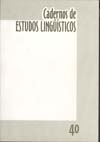Abstract
This paper contends that the two competing "rules" that the literature on Portuguese morphophonology has claimed to apply to the verb paradigm, namely, vowel height harmony and vowel lowering, are, in fact, phonotactic restrictions that apply, in a categorical fashion, to the inflected verb stem and, in a gradient fashion, to the non-inflected verb stem. At least in Brazilian Portuguese, the non-inflected verb stem is consistent with the inflected verb stem in that lowering predominates in both in the first conjugation and harmony predominates in both in the second and third conjugation. Lowering is in turn consistent with other versions of OCP which cut across all grammatical categories. The findings are interpreted in light of Acoustic-Articulatory Phonology (Albano 2001), which predicts, on grounds of facilitation of decoding of acoustic-to-articulatory relations, that stress tends to attract low vowels except where vowel quality is otherwise predictable.References
ALBANO, E. 2001. O gesto e suas bordas: esboço de fonologia acústico-articulatória do português brasileiro. Campinas: Mercado de Letras.
ALBANO, E.; A. Moreira; P. Aquino; A. Silva e R. Kakinohana. 1995. Segment frequency and word structure in Brazilian Portuguese. Proceedings ICPhS 95, vol. 3, pp. 346-349.
ALBANO, E. e A. Moreira. 1996. Archisegment-based letter-to-phone conversion for concatenative synthesis in Portuguese. Proceedings of ICSLP’96, vol. 3, pp. 1708-1711.
CAVACAS, A. A. 1920. A língua portuguesa e sua metafonia. Coimbra: Universidade de Coimbra.
FERREIRA, A. B. H. 1977. Minidicionário Aurélio. Rio de Janeiro: Nova Fronteira.
FRISCH, S. 1996. Similarity and frequency in phonology. Tese de doutorado inédita, Northwestern University.
GAMA ROSSI, A. 1998. Qual é a natureza do acento secundário no português brasileiro? Cadernos Centro Universitário São Camilo, vol. 4(1): 77-92.
GREENBERG, J. 1950. The patterning of root morphemes in semitic. Word, 5: 162-181.
HARRIS, J. 1974. Evidence from Portuguese for the ‘Elsewhere Condition’ in phonology. Linguistic Inquiry, 5(1): 61-80.
KIPARSKY, P. 1973. ‘Elsewhere’ in phonology. In: S. Anderson & P. Kiparsky (eds.). A Festschrift for Morris Halle. New York: Holt.
LEBEN, W. 1973. Suprasegmental phonology. Tese de doutorado inédita, MIT.
LINDBLOM, B. 1995. Modelling speaker-listener interaction. In: Bloothooft, G., V. Hazan, D. Huber e J. Llisterri (orgs.) European Studies in Phonetics and Speech Communication. Utrecht: OTS Publications, 1995, pp. 47-52.
MATEUS, M. H. 1975. Aspectos da fonologia portuguesa. Lisboa: Centro de Estudos Filológicos.
PIERREHUMBERT, J. 1993. Dissimilarity in the Arabic verbal roots. Proceedings of the North East Linguistics Society, 23: 367-381.
PIERREHUMBERT, J. 1994. Syllable structure and word structure. In: P. Keating (org.). Phonological structure and phonetic form: Papers in laboratory phonology III. Cambridge: Cambridge University Press, pp. 168190.
The journal CADERNOS DE ESTUDOS LINGUÍSTICOS is granted all the copyright related to the published works. The originals will not be returned. By virtue of being part of this public access journal, the articles are free to use, with their own attributions, in educational and non-commercial applications

